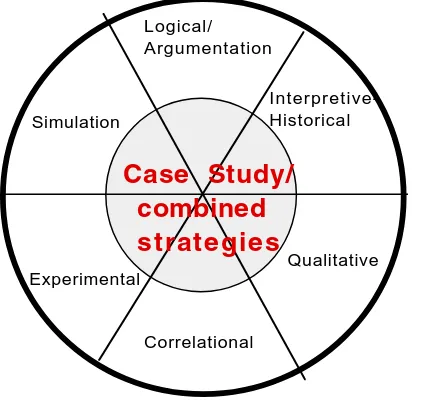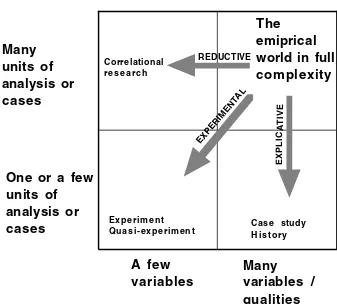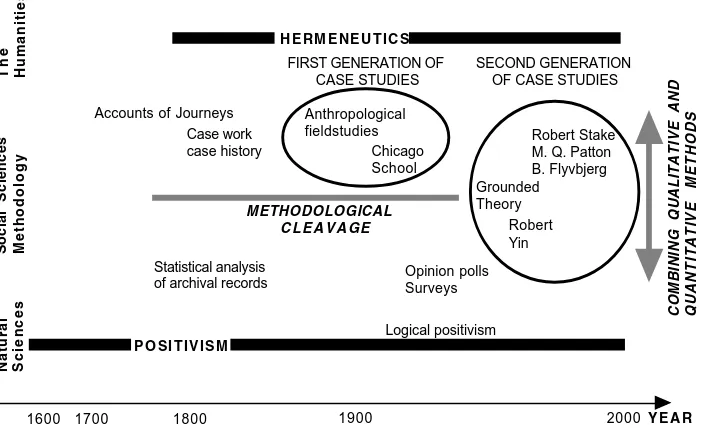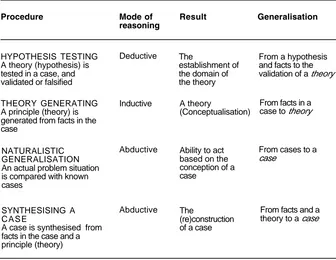Case Study Methodology
Rolf Johansson
Architect SAR/MSA, Associate Professor. Royal Institute of Technology
Infrastructure / Urban Studies / Built Environment Analysis [email protected]
A case study is expected to capture the complexity of a single case, and the methodology which enables this has developed within the social sciences. Such methodology is applied not only in the social sciences, such as psychology, sociology, anthropology, and economics, but also in practice-oriented fields such as environmental studies, social work, education, and business studies. As we can see from the papers presented at this conference, case studies are very well represented. At least a third of the papers discuss some aspect of case study methodology.
In this presentation I will try to capture the essence of case study methodology: firstly, by discussing the notions of “case study” and “case”; secondly, by tracing its history; and finally, by making explicit its most characteristic features.
The notions of “Case study” and “case”
There are different ideas about what a case study is. If I try to find a common denominator that case study researchers (Yin 1994; Merriam 1994; Stake 1995, 1998; Miles & Huberman 1994; Gillham 2001) might agree on, it would be something along the following lines:
The case study should have a “case” which is the object of study. The “case” should
• be a complex functioning unit,
• be investigated in its natural context with a multitude of methods, and • be contemporary.
Nevertheless, the case study researchers mentioned above emphasise different features. Robert Stake (1998) points out that crucial to case study research are not the methods of investigation, but that the object of study is a case: “As a form of research, case study is defined by interest in individual cases, not by the methods of inquiry used”. Other researchers, such as Robert Yin (1994), place more emphasis on the method and the techniques that constitute a case study.
The concept of “case study” introduces the first issue that I will discuss: how is the case study related to other research methods? One major feature of case study methodology is that different methods are combined with the purpose of illuminating a case from different angles: to triangulate by combining
methodologies. In a recently published book, Architectural Research Methods by Linda Groat and David Wang (2002), the relation between different research strategies in the field of architecture is illustrated as in figure 1. Groat & Wang explain the relations between methodologies, as shown in their diagram, by arguing that those close to each other have more similarities than those that are further apart. Qualitative and interpretive research have in common a holistic approach to the research subject, but with differing time perspectives.
Correlational research, on the other hand, shares with qualitative research a focus on naturally occurring circumstances, but is dependent on quantitative data. Experimentation is also dependent on quantitative data, but with the requirement that the researcher must be able to manipulate isolated variables. Likewise, simulation requires control and manipulation. Logical argumentation — which includes, for instance, space syntax analysis — shares with simulation an emphasis on abstraction. And interpretive-historical research is dependent on a constructed logic of interpretation. This completes the circle.
Logical/ Argumentation
Interpretive-Historical
Qualitative
Correlational Experimental
Simulation
Case Study/ combined strategies
Figure 1. A conceptual framework for research methods. After Groat and Wang (2002), the
Case studies combine the other research strategies. In that respect the case study could be said to be a meta-method. The purpose of Groat & Wang’s positioning of the case study in the middle of the diagram is not to argue that it is in any respect more important than other methodologies. I argue, though, that in practice-oriented fields of research, such as architecture and planning, the case study has a special importance. The ability to act within professional practice is based on knowledge of a repertoire of cases. These cases are based either on personal experience or are model cases established within the profession. Case studies contribute to the building of a professional repertoire. A designer’s work is based on comparisons between known cases from the repertoire and the actual design situation (Schön 1991).
Quasi-experiment Case studyH i s t o r y
REDUCTIVE
EXPERIMENTAL
EXPLICATIVE
Figure 2. Three strategies to focus empirical research by reducing the units of analysis (cases), the
number of variables (qualities), or both. The three strategies imply different methodologies. Case
studies are a form of explicative strategy.
that are considered, or the number of cases (units of analysis), or both, can be reduced. (Figure 2).
A case study and, normally, history focus on one case, but simultaneously take account of the context, and so encompass many variables and qualities. I have labelled this strategy “explicative” as opposed to “experimental” (one unit of analysis and a few isolated variables) and “reductive” (many units of analysis and a few variables) (Johansson 2002).
The relation between case study and history requires special attention. Case study methodology is developed within the social sciences. A prerequisite of the
development of case study methodology was the focus on contemporary events characteristic of the social sciences. Within research in the field of architecture and planning, an artefact often serves as a focus of attention. When a physical artefact is the case (houses or housing areas, for instance, instead of an individual or a social group) the gap between case study and history tends to diminish. An artefact is a carrier of its history. This is what the philosopher and archaeologist Robin George Collingwood calls his “first principle of a philosophy of history: that the past which an historian studies is not a dead past, but a past which in some sense is still living in the present” (1939/1978:97). The context of design and the context of use may be separated in time, but are often equally important to the
understanding of the case of an artefact. In architectural research, when the case is a physical artefact, case studies often become more or less historical case studies (Johansson 2000a).
I will now discuss the notion of “case”. What is a case? The concept of case is not well defined and remains a subject of debate. The case may be a relatively bounded object or a process; it may be theoretical, empirical, or both (Ragin & Becker 1992). At a minimum, a case is a phenomenon specific to time and space.
The notion of “case” is complicated in another respect. The kind of case on which a case study focuses may change over time. It may change both in the hands of the researcher and in the hands of the researcher’s audiences (Ragin & Becker
different phenomenon. The classic study Street Corner Society by William Foot Whyte (1943/1993), for instance, can be read as it was originally intended by the author: as a multiple-case study of boys’ gangs. It can also be read – which is probably more common today - as a case of participant observation.
The history of case study methodology
A first generation of case studies appeared around 1900, initially within the discipline of anthropology. From early accounts of journeys, systematic investigations of other cultures in the form of field studies emerged, with
participant observation as the predominant method of data collection. Another source of case study methodology has been provided by descriptions of individuals within medicine, social work and psychology, often called “case work” or “case history”. The first generation of case studies culminated in the Chicago school of sociology, in which the anthropologist’s field study method was practised on contemporary society in the university surroundings (Platt 1992, van Maanen 1988).
After the Second World War logical positivism dominated the philosophy of science, and the social sciences favoured positivism and quantitative methods. Surveys, statistical methods, opinion polls, experiments, and quasi-experiments were considered scientific, and qualitative case studies were criticised for being non-scientific. During this period differing methodologies led to a distinction within the social sciences between two cultures: positivistic and anti-positivistic. Thus the social sciences were characterised by a methodological division. This reflected the birth and development of the social sciences within the context of existing tensions between the natural sciences and the humanities.
gap between positivism and hermeneutics as a philosophical foundation of the social sciences.
The first type of methodology within the second generation of case studies was Grounded Theory. This methodology merged qualitative field study methods from the Chicago school of sociology with quantitative methods of data analysis (Glaser & Strauss 1967). The result was an inductive methodology that was based on using detailed procedures to analyse data. Robert Yin (1984/1994) took the next step. He transferred experimental logic into the field of naturalistic inquiry and combined it with qualitative methods. Since then, much has been written on case study methodology. Case study methodology has developed in the direction of eclecticism and pragmatism. This development has been advocated by, among others, Michael Quinn Patton (1990:39): “Rather than believing that one must choose to align with one paradigm or the other, I advocate a paradigm of choices. A paradigm of choices rejects methodological orthodoxy in favour of methodological
appropriateness as the primary criterion for judging methodological quality”. Case
study methodology now bridges the methodological gap in the social sciences
(Figure 3).
The Humanities
Social Sciences Methodology
Natural Sciences
Y E A R
1600 1700 1800 1900 2000
H E R M E N E U T I C S
of archival records Opinion pollsSurveys
SECOND GENERATION
COMBINING QUALITATIVE AND QUANTITATIVE METHODS
Figure 3. The history of case study methodology. The first generation of case studies was an
isolated island within the development of methodology in the social sciences. After the Second
World War it received heavy criticism from the logical positivists. Over the last few decades case
The characteristic features of case study methodology
Unlike the first generation of case study research, the aim of the second generation has been to make methods explicit. Different important aspects of case study methodology are exhaustively discussed: How are findings validated? How is a case for study selected? And, how are generalisations made from a single case?
Triangulation provides an important way of ensuring the validity of case study
research. Normally, data collection methods are triangulated (many methods are combined), but in addition to this, data sources, theory, or investigators might also be triangulated (Denzin 1978). I have noticed that different concepts of validation in quantitative and qualitative research sometimes create confusion when they are combined, as they often are in case studies.
How is a case for study selected? The case might be given and studied with an intrinsic interest in the case as such. In such a case the researcher has no interest in generalising his or her findings. The researcher focuses on understanding the case. If the findings are generalised, it is done by audiences through “naturalistic generalisation”. I will soon elaborate on this.
The alternative to an intrinsic case study is a purposefully or analytically selected case. A case may be purposefully selected in virtue of being, for instance, information-rich, critical, revelatory, unique, or extreme (as opposed to cases selected within a representational sample strategy used in correlational research) (Stake 1995, Patton 1990). If a case is purposefully selected, then there is an interest in generalising the findings.
I will now investigate the issue of generalisation, since this is the issue over which case study methodology has been most questioned. How are generalisations made from a single case? Generalisations from cases are not statistical, they are
When a generalisation is based on the deductive principle, the procedure is similar to an experiment: a hypothesis is formulated, and testable consequences are derived by deduction. By comparing the expected findings, which are deduced from a theory and a case, with the empirical findings, it is possible to verify or falsify the theory. As a result it is possible to define the domain within which the theory is valid more exactly. Cases that are pivotal to the theory are selected. The testing of the theory is comprised of the emulation of experimental method in a naturalistic setting. From a theory and the facts of a case, generalisations are drawn concerning the domain of the theory. This model of the way in which generalisations are drawn from a case is developed by Robert Yin.
A second mode of generalisation is achieved through induction. In case studies this is done through inductive theory-generation, or conceptualisation, which is based on data from within a case. The result is a theory normally consisting of a set of related concepts. According to Grounded Theory, this is the way in which generalisations are made (Glaser & Strauss 1967).
The third type of generalisation depends on the principle of abduction. Deduction and induction are familiar to everyone, but possibly not abduction. According to the principle of deduction a conclusion is necessarily true from a case and a rule. If the premises are true, the conclusion is also true. Deduction proves that something must be true. By induction we can conclude from facts in a case a rule that actually is operative, and probably is operative, in similar cases. Abduction is the process of facing an unexpected fact, applying some rule (known already or created for the occasion), and, as a result, positing a case that may be. The concept of abduction was coined by the pragmatist philosopher Charles Sanders Peirce: “The surprising fact, C, is observed; But if A were true, C would be a matter of course, Hence, there is reason to suspect that A is true” (CP 5.189). But Peirce also indicates that there are two kinds of abduction:
Now, returning to the topic of generalising from a case, these two kinds of
abduction indicate two more possible types of generalisation. One is when a case is created (reconstructed) by a process of abductive reasoning from a few facts; for instance, historical data or clues.Within the social sciences, the historian Carlo Ginzburg refers to these kinds of generalisation as occuring within the “evidential paradigm” (Ginzburg 1989).
The other kind of generalisation, based on abduction, is operative when generalisations are made from known cases and applied to an actual problem situation by making appropriate comparisons. This is also called naturalistic generalisation (Stake 1995). Designers practise naturalistic generalisation when they refer to their repertoire of familiar cases in implementing new designs. (Figure
4).
Procedure Mode of
reasoning
Result Generalisation
HYPOTHESIS TESTING A theory (hypothesis) is tested in a case, and validated or falsified
THEORY GENERATING A principle (theory) is generated from facts in the case
NATURALISTIC GENERALISATION An actual problem situation is compared with known cases
SYNTHESISING A CASE
A case is synthesised from facts in the case and a
Figure 4. Modes of generalisation and reasoning within case study methodology.
generating are combined in practice. He names this combined approach “adaptive theory approach”.
Conclusion
I will conclude by summarizing the reflections on case study methodology that I have made in this presentation.
The essence of case study methodology is triangulation, the combination on different levels of techniques, methods, strategies, or theories. I believe case studies develop through the mastery of such combinations.
The division between history and case study is often uncalled for when the case is an artefact. Case studies with a stronger methodological influence from historical research will probably develop: historical case studies in which case study
methodology and history combine.
The combination of qualitative and quantitative approaches is well established in case studies, but nonetheless, the differing quality standards — regarding truth, applicability, consistency, and neutrality — in qualitative and quantitative research are difficult to codify.
Finally, the principal issue of the debate: how we may generalise from a case. Maybe we will see case studies where the different modes of generalisation are explicitly combined.
Acknowledgements
References
Collingwood, Robin George. (1939/1978). An Autobiography. Oxford: Clarendon. Collingwood, Robin George. (1943/1994). The Idea of History. Oxford: Oxford
University Press.
Denzin, Norman K. (1978). The research act: A theoretical introduction to sociological
methods. (2nd ed.). New York: McGraw-Hill.
Gillham, Bill. (2001). Case Study Research Methods. London, New York: Continuum. Groat, Linda, & Wang, David. (2002). Architectural research Methods. New York: John
Wiley & sons.
Ginzburg, Carlo. (1989). “Clues: Roots of an Evidential Paradigm”. In Carlo Ginzburg. Clues, Myths, and the Historical Method. Baltimore: John Hopkins University Press.
Glaser, Barney, & Strauss, Anshelm. (1967). The Discovery of grounded Theory:
Strategies for qualitative research. Chicago: Aldine.
Johansson, Rolf. (2000a). “Ett bra fall är ett steg framåt. Om fallstudier, historiska studier och historiska fallstudier”. Nordic Journal of Architectural Research, 13, no 1–2, 65-71.
Johansson, Rolf. (2000b). “Om abduktion, intuition och syntes”. Nordic Journal of
Architectural Research, 13, no 3, 13-19.
Johansson, Rolf. (2002). “Ett explikativt angreppsssätt – Fallstudiemetodikens utveckling, logiska grund och betydelse i arkitekturforskningen”. Nordic Journal
of Architectural Research, 53, no 2, 19–28.
Layder, Derek. (1998). Sociological Practice. Linking theory and social research. Thousand Oaks: Sage.
Merriam, Sharan B. (1988). Case Study Research in Education. San Fransico: Jossey-Bass Inc. Publ.
Miles, Matthew B. & Huberman, A. Michael. (1994). Qualitative Data Analysis. Thousand Oaks: Sage.
Peirce, Charles Sanders. (1992). The Collected papers of Charles Sanders Peirce. Electronic Edition. Past masters. Charlottesville: InteLex Corporation. (Originally pub. 1931–35 and 1958).
Patton, Michael Quinn. (1990). Qualitative Evaluation and Research Methods. Thousand Oaks, London, New Delhi: Sage.
Platt, Jennifer. (1992). “‘Case study’ in American methodological thought”. Current
Ragin, Charles C. & Becker, Howard S. (1992). What is a Case? Exploring the
Foundations of Social Inquiry. Cambridge, USA: Cambridge University Press.
Schön, Donald A. (1991). The Reflective Practitioner: How professionals think in action. Aldershot, Hants: Arena.
Stake, Robert. (1995). The Art of case study Research. Thousand Oaks, London, New Delhi: Sage.
Stake, Robert. (1998). “Case Studies” in: Norman Denzin & Yvonna Lincoln. (eds.): Strategies of Qualitative Inquiry. Thousand Oaks, London, New Delhi: Sage. Van Maanen, John. (1988). Tales of the Field: On writing ethnography. Chicago:
University Press.
Whyte, William Foot. (1943/1993). Street Corner Society. Chicago: The University of Chicago Press.
Winch, Peter. (1958/1994). Samhällsvetenskapens idé och dess relation till filosofin. Stockholm: Thales.
Von Wright, Georg Henrik. (1971). Explanation and Understanding. Ithaca, New York: Cornell University Press.



